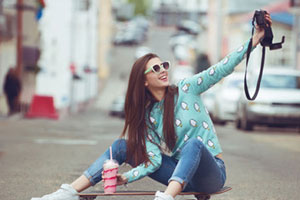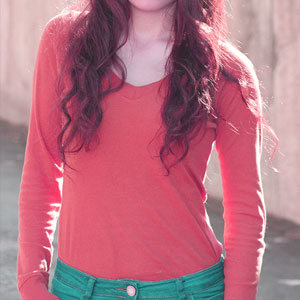How to match colors of clothes for a hip style
If you are wondering how to match colors, there is one person you have to think about: Isaac Newton. He was the one to hold a prism to the sun and find that white light breaks down into different colors. By turning the vertical color stripes into a wheel, he created the color wheel. This will come in handy when you want to look great at a concert, for example. In our days the color wheel contains more hues than back then, thus becoming even more useful when you have a wardrobe-crisis and you don't know what to wear.

Ways to mix and match colors
1. Warm and cool colors
If you are thinking about matching colors, you should know that the color wheel can be divided into cool and warm tones. The cool tones work with other cool tones and the warm ones match other warm ones.
2. Analogous colors
Analogous colors are those located near each other on the color wheel, such as red, tangerine, and orange. These work together effortlessly and they look simply stunning. This is the way to go if you want to have heads turning after you.
3. Complementary colors
Complimentary colors are those that can be found across the color wheel, such as navy and orange. You can also choose two analogous colors and a complementary one for the best results. Think about violet, indigo, and orange.
4. Primary colors
Color matching isn't difficult if you know your colors. For starters there are the primary colors: red, yellow, and blue. By mixing these, you can achieve all the other colors. However, there is no reason for you not to go for primary colors in your clothes.
5. Color wheel
The color wheel is meant to offer you a baseline or a guide according to which you should choose your colors. Even if you don't have a natural sense for colors, this wheel will tell you exactly which colors work together and which don't.
6. Neutral and earthy colors
Earthy and neutral colors cannot be found on the color wheel. If you want to match colors, you should be thinking about the muted colors. These are easy to mix and match because they work with almost any other color.
7. Black and white
In fashion black and white are considered neutral colors, but they are still a separate entity. These colors work with any other color and they also work well together. If you don't know what color to choose, there is no way to go wrong with black and white.
Learn How to Match Colors and Open the Door to a Whole New World for Yourself and for Your Wardrobe as Well
So, what should you know about matching colors? How will color theory help you with your possible wardrobe malfunctions?
1. Warm and cool colors don't mix and match
Color matching isn't really difficult if you know the basics. For starters, there are the cool colors (like blue, purple, and green) and the warm colors (red, orange, and yellow). All colors can have a cool or warm tone, depending on what color components they have. If you want consistency in your look, you should make sure you only mix cool colors with other cool colors and warm colors with other warm colors. For instance, you could wear a rust colored dress with a cognac purse and a mustard yellow scarf. In some situations you can match colors of different "temperatures" to achieve a funky look, but if you don't really know what you're doing, the results may end up being disastrous.
2. Analogous colors – can't live without them
It's not difficult to match color if you know the color wheel. Analogous colors refer to the neighboring colors of the color wheel. These work together without any effort and you can find such combinations in nature as well. For the best results you should choose one leading color, with the others having a supportive role. Although they might be analogous, you shouldn't mix bold colors and pastels. This is because the bolds will make the pastels look muted. In case you feel bold, you could be thinking about fuchsia, orange, and red in the same outfit. For a more muted look there are aqua, periwinkle, and pale blue.
3. Complementary colors of the color wheel
Opposites attract, remember? This logic applies to matching color schemes as well. Complimentary colors refer to the colors found on the opposite sides of the color wheel. You could also use split complementary colors. This means two adjacent colors and one complimentary color. The two adjacent colors should be the dominant ones with the complimentary color being the "surprise". Regarding proportions, you should consider the 75-25 rule. When looking for bold combinations, you could consider violet, orange, and indigo. For instance, you could wear a blouse with violate and indigo patterns and play it up with a pair of orange earrings. Purple grey and plum have the matching color yellow.
4. Primary colors – basic options
The truth about matching colors clothes is that the primary colors (red, blue, and yellow) are difficult to pull off together. Nonetheless, they work very well for monochromatic looks. For instance, you could opt for a pair of blue jeans, white blouse, blue ankle boots, and a blue jacket. To break the monotony, you could also throw in a red scarf. In order to pull off all three of them in the same outfit, you have to find matching colors that will break them up. As an example, you could wear red heels, blue jeans, a grey top, black jacket, and yellow earrings. Breaking colors up means you let them "breathe" and you don't use them right besides each other.
5. Color wheel – everything starts with the color wheel
We referred to the color wheel many times and this is because this is what determines the colors that match. Although not all shades and hues can be found on it, if you use it, you will get a pretty good idea about which colors work well together and which don't. As an example, although it is said that black works with everything, you shouldn't mix it with brown and navy blue. However, you might find some color matching clothes, but you should go for sure combinations only if you are absolutely certain of what you're doing. Similarly, white and cream don't really match either. Brown and grey look strange together too and they were never meant to be.
Some other combinations should also be avoided, such as wearing green with red. In theory you might think that you will get an interesting result, but the truth is that the result will be plain and simply weird.
6. Neutral and earthy colors work well together
You shouldn't be looking for earth tones on the color wheel, because there aren't any. The truth is that these colors are difficult to define; as a matter of fact, they are based on fashion rather than science. Usually these are muted colors like cream, brown, grey, slate, and white. When asking how to match colors of clothes, you should know that these are easy to mix and match as they work well with most colors and they remind us of the elements of nature. Some fashion gurus consider khaki and tan neutrals too when matching and the same goes for blue denim.
No matter how easy it is to mix and match them, you should still take into consideration the temperature of the colors. Even if you are thinking about black and white as being neutrals, you should make sure they don't have an undertone. For instance, off-white could have a yellow undertone, making it a warm color.
7. Black and white – monochromes
A lot is said about black and white and a lot of people think that they match every other color, but they don't. As it has been mentioned before, there are certain colors they don't mix well with and there is also the possibility for them to have an undertone, making it more difficult to match them. However, if you don't really know how to match color and you want to have a safe bet, you can't really go wrong with black or white. As a matter of fact, you could wear them together. Nonetheless, you have to remember that a black and white ensemble is quite bold and you will have people staring at you (not that it's a bad thing).
Colors can be your friends if you know how to use them. If you don't really have a sense for this, you should play it safe, to avoid fashion mishaps. In case you need a little help, you can always turn to the color wheel.







